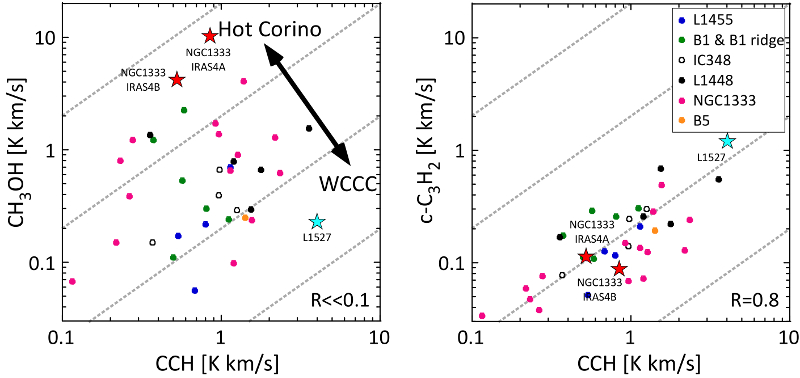| EPoS Contribution |
|
Chemical Diversity in Low-Mass Star-Forming Cores and It's Future toward the Protoplanetary Disks
Nami Sakai RIKEN, Saitama, JP | |
|
It is well known that low-mass protostellar cores show significant chemical diversity. One distinct case is hot corino chemistry characterized by rich saturated complex organic molecules, while the other distinct case is warm carbon-chain chemistry (WCCC) characterized by rich carbon-chain molecules.
However, only a few sources each are definitively classified into them, and the statistics is apparently poor.
To overcome this situation, we have conducted an unbiased survey of chemical composition toward 37 Class 0 and Class I protostars in the Perseus molecular cloud complex at the 1.3 mm and 3 mm bands with the IRAM 30 m telescope and the NRO 45 m telescope, respectively.
We have detected multi-transition lines of CCH, c-C3H2, and CH3OH toward most of the sources.
The result shows clear chemical diversity, where many intermediate sources between the two distinct cases are found.
Especially, we have found a marginal but interesting trend that isolated sources and sources in cloud peripheries tend to be like the WCCC source.
The relative occurrence of each category (hot corino chemistry, WCCC, or intermediate) as well as preferential association of the sources in each category with a specific part of the cloud complex will give us an important clue to understanding the origin of the chemical diversity in terms of evolutionary and/or environmental effects.
More importantly, we have recently studied sub-arcsecond molecular distributions in the prototypical WCCC source L1527 and the prototypical hot corino source IRAS 16293-2422 observed with ALMA, and have found that the chemical diversity is also evident in the closest vicinity (~100 AU) around the protostar. In the WCCC source L1527, the infalling-rotating envelope is well traced by CCH, c-C3H2, and CS, and its centrifugal barrier r = 100 AU is highlited by SO. Carbon-chain molecules are depleted onto dust grain after passing through the centrifugal barrier, and are thought to be delivered to the protoplanegary disk in the solid phase. In the hot corino source, the infalling-rotating envelope is traced by OCS, and its centrifugal barrier (r = 50 AU) is highlighted by the saturated organic molecules, CH3OH and HCOOCH3. Considering these ALMA results along with the chemical diversity of the protostellar cores found in the Perseus region, significant chemical diversity is expected in a disk-forming zone (~100 AU) and even in protoplanetary disks. Thus, the chemical diversity is becoming more and more important in considering the "chemical" origin of the Solar System. | |
 | |
| Caption: (Left) The correlation plot between the integrated intensities of the the CCH (N=3-2, J=7/2-5/2, F=4-3, Eu=25 K) and CH3OH (J=5-4, K=0 A, Eu=50 K) line. (Right) The correlation plot between the integrated intensities of the the CCH (N=3-2, J=7/2-5/2, F=4-3, Eu=25 K) and c-C3H2 (321-212, Eu=18 K) line. | |
| Collaborators: C. Ceccarelli, IPAG, FR B. Lefloch, IPAG, FR M. Imai, U Tokyo, JP Y. Oya, U Tokyo, JP A. Lopez-Sepulcre, U Tokyo, JP S. Yamamoto, U Tokyo, JP |
Key publication
Suggested Session: Chemistry |

